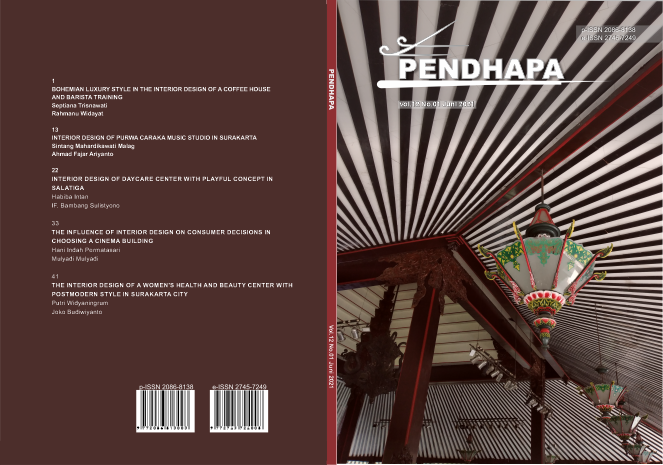Interior Design of Daycare Center with Playful Concept in Salatiga
DOI:
https://doi.org/10.33153/pendhapa.v12i1.3517Keywords:
Interior Design, Daycare Center, PlayfulAbstract
Along with the rise in career women, the community is seeing an increase in daycare centers to prevent child abuse and provide early childhood education. Language skills, character development, creativity, and motor skills are all part of this education. However, most daycares, particularly those for youngsters, place less emphasis on amenities and infrastructure. Many daycares have not followed the rules. As a result, a concept arose for a Daycare Center with a Playful Concept in the City of Salatiga, complete with an infant room, playground, classroom, sleeping room, canteen, and Office.
Downloads
References
de Souza Morais, R. L., de Castro Magalhães, L., Nobre, J. N. P., Pinto, P. F. A., da Rocha Neves, K., & Carvalho, A. M. (2021). Quality of the home, daycare and neighborhood environment and the cognitive development of economically disadvantaged children in early childhood: A mediation analysis. Infant Behavior and Development, 64, 101619. https://doi.org/10.1016/j.infbeh.2021.101619
Givoni, B. (1991). Impact of planted areas on urban environmental quality: A review. Atmospheric Environment. Part B. Urban Atmosphere, 25(3), 289–299. https://doi.org/10.1016/0957-1272(91)90001-U
Hammershøj, L. G. (2021). Creativity in children as play and humour: Indicators of affective processes of creativity. Thinking Skills and Creativity, 39, 100784. https://doi.org/10.1016/j.tsc.2020.100784
Harbizadeh, A., Mirzaee, S. A., Khosravi, A. D., Shoushtari, F. S., Goodarzi, H., Alavi, N., Ankali, K. A., Rad, H. D., Maleki, H., & Goudarzi, G. (2019). Indoor and outdoor airborne bacterial air quality in day-care centers (DCCs) in greater Ahvaz, Iran. Atmospheric Environment, 216, 116927. https://doi.org/10.1016/j.atmosenv.2019.116927
Hwang, S. H., Seo, S., Yoo, Y., Kim, K. Y., Choung, J. T., & Park, W. M. (2017). Indoor air quality of daycare centers in Seoul, Korea. Building and Environment, 124, 186–193. https://doi.org/10.1016/j.buildenv.2017.07.042
Joh, A. S., & Spivey, L. A. (2012). Colorful success: Preschoolers’ use of perceptual color cues to solve a spatial reasoning problem. Journal of Experimental Child Psychology, 113(4), 523–534. https://doi.org/10.1016/j.jecp.2012.06.012
Kuzinas, A. (2013). The Power of Colour on Content: Associations, Evoked by Simple and Complex Pictures. Procedia - Social and Behavioral Sciences, 84, 1397–1402. https://doi.org/10.1016/j.sbspro.2013.06.763
Melani, F., & Sari, S. M. (2015). Penerapan Standar Fasilitas Ruang Belajar Pada Taman Kanak-Kanak Katolik Santa Clara Surabaya. Intra, 3(2), 452–458.
Moriya, K., Iio, T., Shingai, Y., Morita, T., Kusunoki, F., Inagaki, S., & Mizoguchi, H. (2021). Playing with invisible animals: An interactive system of floor-projected footprints to encourage children’s imagination. International Journal of Child-Computer Interaction, 100407. https://doi.org/10.1016/j.ijcci.2021.100407
Plass, J. L., Homer, B. D., MacNamara, A., Ober, T., Rose, M. C., Pawar, S., Hovey, C. M., & Olsen, A. (2020). Emotional design for digital games for learning: The effect of expression, color, shape, and dimensionality on the affective quality of game characters. Learning and Instruction, 70, 101194. https://doi.org/10.1016/j.learninstruc.2019.01.005
Santoso, L. B. (2020). Eksistensi Peran Perempuan sebagai Kepala Kelauarga (Telaah terhadap Counter Legal Draf-Kompilasi Hukum Islm dan Qira’ah Mubadalah). Marwah: Jurnal Perempuan, Agama Dan Jender, 18(2), 107. https://doi.org/10.24014/marwah.v18i2.8703
Scharp, Y. S., Breevaart, K., Bakker, A. B., & van der Linden, D. (2019). Daily playful work design: A trait activation perspective. Journal of Research in Personality, 82, 103850. https://doi.org/10.1016/j.jrp.2019.103850
Sugeng, E. J., de Cock, M., Leonards, P. E. G., & van de Bor, M. (2020). Toddler behavior, the home environment, and flame retardant exposure. Chemosphere, 252, 126588. https://doi.org/10.1016/j.chemosphere.2020.126588
Suptandar, J. P. (1982). Perancangan Tata Ruang Dalam (Interior Design). Penerbit PT Djambatan.
Thoring, K., Desmet, P., & Badke-Schaub, P. (2018). Creative environments for design education and practice: A typology of creative spaces. Design Studies, 56, 54–83. https://doi.org/10.1016/j.destud.2018.02.001
Vásquez, N. G., Felippe, M. L., Pereira, F. O. R., & Kuhnen, A. (2019). Luminous and visual preferences of young children in their classrooms: Curtain use, artificial lighting and window views. Building and Environment, 152, 59–73. https://doi.org/10.1016/j.buildenv.2019.01.049
Ward Thompson, C. (2013). Activity, exercise and the planning and design of outdoor spaces. Journal of Environmental Psychology, 34, 79–96. https://doi.org/10.1016/j.jenvp.2013.01.003
Yüksel, M. Y., & Sazcı, A. (2015). An Examination of the Relationship between 9–12-Month-old Children’s Executive Functions and Social Skills. Procedia - Social and Behavioral Sciences, 174, 2012–2020. https://doi.org/10.1016/j.sbspro.2015.01.869
Downloads
Published
Issue
Section
License
Authors who publish with Pendhapa agree to the following terms:
- Authors retain copyright and grant the journal right of first publication with the work simultaneously licensed under a Creative Commons Attribution License (CC BY-SA 4.0) that allows others to share the work with an acknowledgment of the work's authorship and initial publication in this journal.
- Authors are able to enter into separate, additional contractual arrangements for the non-exclusive distribution of the journal's published version of the work (e.g., post it to an institutional repository or publish it in a book), with an acknowledgment of its initial publication in this journal.
- Authors are permitted and encouraged to post their work online (e.g., in institutional repositories or on their website) prior to and during the submission process, as it can lead to productive exchanges, as well as earlier and greater citation of published work.

This work is licensed under a Creative Commons Attribution-ShareAlike 4.0 International License.









